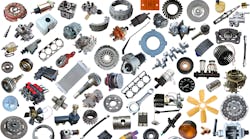Editor’s note: Peter Maithel is automotive industry principal at Infor, a provider of cloud-based business software for a number of industries, including distribution and automotive manufacturing. Maithel has some predictions for the new year.
Prediction 1: Supply chain challenges will continue
Supply chain challenges will continue and will affect internal combustion engines (ICEs) as well as electric vehicles (EVs). The chip shortage, in particular, could affect 2 million to 3 million vehicles in 2023, according to some estimates. The impact will be higher for EVs, as they use approximately 30 percent more chips than do ICEs. Higher interest costs, uncertain economic conditions and greater regulatory burdens will drive financial pressures down through the supply chain, which could lead to further disruptions especially at the sub-tier 1 level.
Two key enablers of supply chain resilience and risk mitigation are connectivity and collaboration between automotive ecosystem participants. Data-driven software platforms that facilitate this — and deliver predictive and prescriptive insights using advanced analytics, artificial intelligence, and machine learning tools — will grow in importance.
Supply chains will need to be revamped to support EV as well as ICE components. Recent U.S. legislation encourages localizing battery sourcing to reduce supply chain risk and qualify for government incentives/tax credits. This is a particular challenge for obtaining minerals, batteries, chips and other components from reliable, ethical and politically approved sources, as these products may not be easily available locally or from "friendly" countries.
Prediction 2: Battery material supply will challenge EV manufacturers
EV manufacturers will struggle to juggle the supply and demand of battery materials, while containing costs, minimizing environmental impacts, and scaling up production.
It’s the proverbial Catch-22 situation: assuming demand projections are accurate, increasing EV production means increasing demand for battery materials sourced from environmentally problematic mines, and processed and transported by means that emit high levels of CO2. The industry needs to look holistically beyond just tailpipe emissions to the environmental impact of the production, refining and transportation of the materials on a global scale.
The sheer volume of the projected demand for battery raw materials means that the auto industry will need an additional 50 lithium, 60 nickel and 17 cobalt mines — but it can take up to 10 years and billions of dollars to get just one mine up and running. This reality will be a further constraint on supply into the foreseeable future. Deep ocean harvesting of mineral-rich nodules has the potential to provide massive quantities of raw materials quicker than land-based mine development but is running afoul of environmental groups.
To add to the challenge, uncertainty about future battery chemistries also acts as a check on the capital-intensive battery materials industry, regardless of how and where the materials are sourced.
Apart from battery-related issues, the costs of e-drive components such as motors rose over 25 percent in 2021, and this trend is expected to continue.
All of the above factors will push EV prices ever higher, further hindering the achievement of price parity with ICE vehicles.
Prediction 3: Alternative fuel sources will become increasingly important in the energy conversation
Battery electric vehicles (BEVs) cannot address the needs of every market around the world. Hydrogen fuel cells hold promise, especially for long-haul trucking as well as rail and shipping. Some analysts echo this sentiment, based on venture capital investment trends. Hydrogen fuel cells have high energy density, quick refueling times and a weight (and hence payload and profitability) advantage over BEVs, which are critical considerations for heavy-duty trucks. Underscoring this trend, Hyundai will offer fuel cell versions of its entire commercial fleet by 2028, and Toyota is partnering with Kenworth on heavy duty (Class 8) fuel cell trucks, and with Isuzu and Hino on medium duty fuel trucks.
Hydrogen will also gain importance as an internal combustion fuel especially for commercial applications. This has obvious advantages in terms of compatibility and retrofitting existing fleets, as many powertrain components are interchangeable. Hydrogen internal combustion engines have similar cost, performance, efficiency and durability characteristics as diesel engines, and, hence, are a good option to replace diesel for trucking, dump trucks, snowplows, emergency vehicles, farm, construction, ports and the like.
Toyota and Cummins are key players in this area. Cummins recently unveiled a 15-liter prototype "fuel-agnostic" combustion truck engine that can run on hydrogen and plans to bring it to market by 2027. Werner Enterprises, a major long-haul trucking company, has committed to purchasing 500 hydrogen combustion engines from Cummins. Volvo is continuing to develop its standard ICEs while also exploring hydrogen, and Daimler plans to offer fuel-agnostic engines as well.
Hydrogen’s biggest challenge is a lack of refueling infrastructure, though we can expect to see rapid growth of investment to address this.
In addition to Hydrogen, research is also ongoing in e-fuels. These synthetic fuels extract carbon from the air to produce a fuel that can burn in standard IC engines. E-fuels are, in theory, net zero carbon, as they emit the same amount as is consumed in their creation. They have the advantage of being a high energy density ‘drop in’ solution, though cost and efficiency are challenges that need to be addressed. We can expect further developments in this area.
Prediction 4: Battery recycling will be a growing challenge
According to some estimates, over 10 million batteries are projected to reach the end of their vehicle life by 2030. Even assuming that 90 percent will be repurposed for second-life uses such as grid energy storage, that will still leave 1 million batteries that will need to be recycled and properly disposed of. At an average weight of 1,000 pounds per battery, that equates to 1 billion tons of highly toxic battery chemicals. As of a year ago, the global annual recycling capacity was estimated at only 100,000 tons. Even though research and investments in battery recycling is increasing, this is a looming challenge for the industry, especially in light of increasingly stringent sustainability and regulatory mandates.
The concept of battery passports will gain importance to aid in the tracking of batteries through their life cycle — from origin to second-life uses and then on to recycling and disposal. This will become increasingly important as EV and battery manufacturers are required to comply with various regulations around the globe.
Prediction 5: In-vehicle software will play an ever-increasing role in defining and upgrading vehicle capabilities and options
In a recent article, Goldman Sachs Research estimates that vehicles could have as many as 650 million lines of code by 2025, up exponentially from 200 million lines just 12 years ago. In contrast, a typical smartphone operating system or fighter aircraft has a "mere" 20-40 million lines of code. This increase is driven by the explosion in vehicle connectivity and ADAS (advanced driver assistance systems). Over-the-air (OTA) software updates provide a way for OEMs to monetize and deliver additional software-driven features over the entire life of the vehicle instead of just at the point of sale and deliver a more bespoke vehicle ownership experience.


